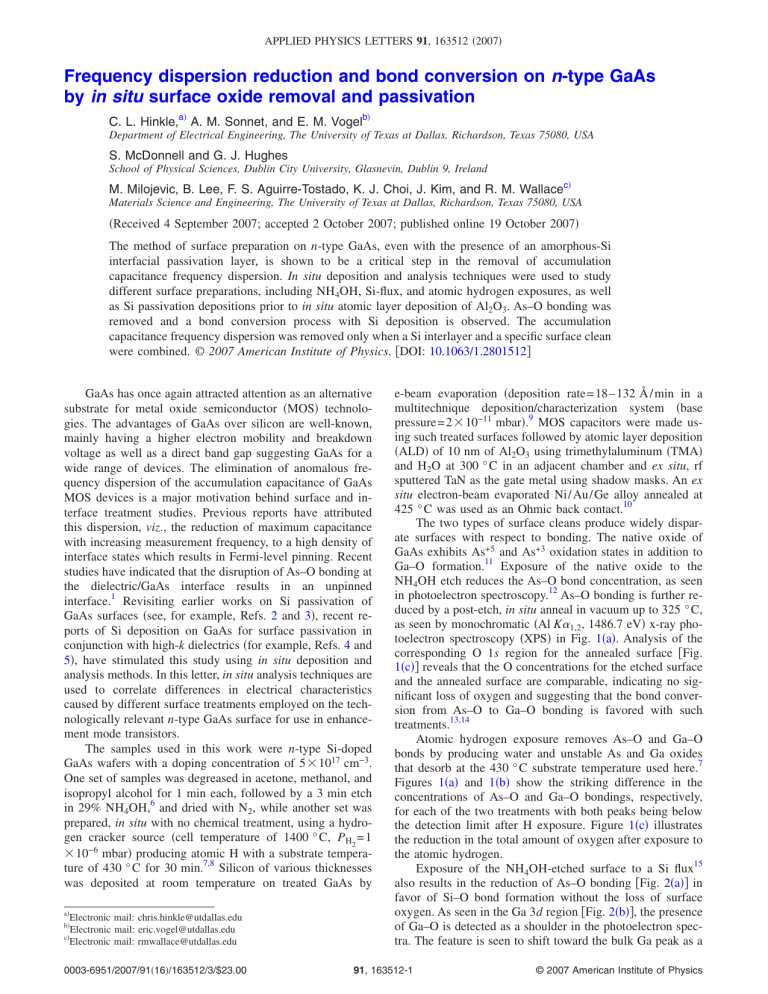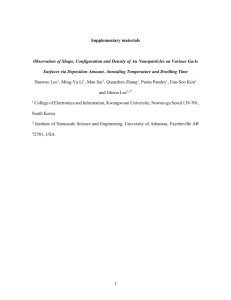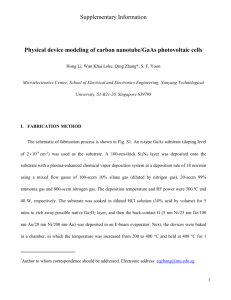Frequency dispersion reduction and bond conversion on n
advertisement

APPLIED PHYSICS LETTERS 91, 163512 共2007兲 Frequency dispersion reduction and bond conversion on n-type GaAs by in situ surface oxide removal and passivation C. L. Hinkle,a兲 A. M. Sonnet, and E. M. Vogelb兲 Department of Electrical Engineering, The University of Texas at Dallas, Richardson, Texas 75080, USA S. McDonnell and G. J. Hughes School of Physical Sciences, Dublin City University, Glasnevin, Dublin 9, Ireland M. Milojevic, B. Lee, F. S. Aguirre-Tostado, K. J. Choi, J. Kim, and R. M. Wallacec兲 Materials Science and Engineering, The University of Texas at Dallas, Richardson, Texas 75080, USA 共Received 4 September 2007; accepted 2 October 2007; published online 19 October 2007兲 The method of surface preparation on n-type GaAs, even with the presence of an amorphous-Si interfacial passivation layer, is shown to be a critical step in the removal of accumulation capacitance frequency dispersion. In situ deposition and analysis techniques were used to study different surface preparations, including NH4OH, Si-flux, and atomic hydrogen exposures, as well as Si passivation depositions prior to in situ atomic layer deposition of Al2O3. As–O bonding was removed and a bond conversion process with Si deposition is observed. The accumulation capacitance frequency dispersion was removed only when a Si interlayer and a specific surface clean were combined. © 2007 American Institute of Physics. 关DOI: 10.1063/1.2801512兴 GaAs has once again attracted attention as an alternative substrate for metal oxide semiconductor 共MOS兲 technologies. The advantages of GaAs over silicon are well-known, mainly having a higher electron mobility and breakdown voltage as well as a direct band gap suggesting GaAs for a wide range of devices. The elimination of anomalous frequency dispersion of the accumulation capacitance of GaAs MOS devices is a major motivation behind surface and interface treatment studies. Previous reports have attributed this dispersion, viz., the reduction of maximum capacitance with increasing measurement frequency, to a high density of interface states which results in Fermi-level pinning. Recent studies have indicated that the disruption of As–O bonding at the dielectric/GaAs interface results in an unpinned interface.1 Revisiting earlier works on Si passivation of GaAs surfaces 共see, for example, Refs. 2 and 3兲, recent reports of Si deposition on GaAs for surface passivation in conjunction with high-k dielectrics 共for example, Refs. 4 and 5兲, have stimulated this study using in situ deposition and analysis methods. In this letter, in situ analysis techniques are used to correlate differences in electrical characteristics caused by different surface treatments employed on the technologically relevant n-type GaAs surface for use in enhancement mode transistors. The samples used in this work were n-type Si-doped GaAs wafers with a doping concentration of 5 ⫻ 1017 cm−3. One set of samples was degreased in acetone, methanol, and isopropyl alcohol for 1 min each, followed by a 3 min etch in 29% NH4OH,6 and dried with N2, while another set was prepared, in situ with no chemical treatment, using a hydrogen cracker source 共cell temperature of 1400 ° C, PH2 = 1 ⫻ 10−6 mbar兲 producing atomic H with a substrate temperature of 430 ° C for 30 min.7,8 Silicon of various thicknesses was deposited at room temperature on treated GaAs by a兲 Electronic mail: chris.hinkle@utdallas.edu Electronic mail: eric.vogel@utdallas.edu c兲 Electronic mail: rmwallace@utdallas.edu b兲 0003-6951/2007/91共16兲/163512/3/$23.00 e-beam evaporation 共deposition rate= 18– 132 Å / min in a multitechnique deposition/characterization system 共base pressure= 2 ⫻ 10−11 mbar兲.9 MOS capacitors were made using such treated surfaces followed by atomic layer deposition 共ALD兲 of 10 nm of Al2O3 using trimethylaluminum 共TMA兲 and H2O at 300 ° C in an adjacent chamber and ex situ, rf sputtered TaN as the gate metal using shadow masks. An ex situ electron-beam evaporated Ni/ Au/ Ge alloy annealed at 425 ° C was used as an Ohmic back contact.10 The two types of surface cleans produce widely disparate surfaces with respect to bonding. The native oxide of GaAs exhibits As+5 and As+3 oxidation states in addition to Ga–O formation.11 Exposure of the native oxide to the NH4OH etch reduces the As–O bond concentration, as seen in photoelectron spectroscopy.12 As–O bonding is further reduced by a post-etch, in situ anneal in vacuum up to 325 ° C, as seen by monochromatic 共Al K␣1,2, 1486.7 eV兲 x-ray photoelectron spectroscopy 共XPS兲 in Fig. 1共a兲. Analysis of the corresponding O 1s region for the annealed surface 关Fig. 1共c兲兴 reveals that the O concentrations for the etched surface and the annealed surface are comparable, indicating no significant loss of oxygen and suggesting that the bond conversion from As–O to Ga–O bonding is favored with such treatments.13,14 Atomic hydrogen exposure removes As–O and Ga–O bonds by producing water and unstable As and Ga oxides that desorb at the 430 ° C substrate temperature used here.7 Figures 1共a兲 and 1共b兲 show the striking difference in the concentrations of As–O and Ga–O bondings, respectively, for each of the two treatments with both peaks being below the detection limit after H exposure. Figure 1共c兲 illustrates the reduction in the total amount of oxygen after exposure to the atomic hydrogen. Exposure of the NH4OH-etched surface to a Si flux15 also results in the reduction of As–O bonding 关Fig. 2共a兲兴 in favor of Si–O bond formation without the loss of surface oxygen. As seen in the Ga 3d region 关Fig. 2共b兲兴, the presence of Ga–O is detected as a shoulder in the photoelectron spectra. The feature is seen to shift toward the bulk Ga peak as a 91, 163512-1 © 2007 American Institute of Physics 163512-2 Hinkle et al. FIG. 1. 共a兲 As 2p3/2, 共b兲 Ga 2p3/2, and 共c兲 O 1s spectra showing marked difference in surface oxygen between NH4OH clean, 325 ° C anneal, ALD Al2O3 deposition, and atomic hydrogen exposure. function of Si-flux exposure, suggesting that the Si exposure gradually results in Ga–O–Si bonding over Ga–O–As bonding. The ratio of the Ga–O peak area to the bulk Ga peak area indicates that there is no detectable loss of Ga–O bonds, consistent with a bond conversion process. We note that under the in situ deposition techniques employed here, no As– O–Si bonding is detected in contrast to previous reports.4 The amount of SiOx that arises as the Si is deposited on the differently prepared surfaces as calculated using Si 2p XPS spectra also differs 共not shown兲. On an NH4OH treated surface exposed to a Si deposition of ⬃1.1 nm, 40% of the Si 2p signal is from some form of SiOx rather than Si–Si bonds. The H-treated surface, with a substantially lower amount of oxygen, has a significantly lower percentage of its Si 2p signal due to an oxide after Si deposition. This SiOx layer could be a direct cause of Fermi-level pinning, as reported recently.16 The capacitance-voltage 共C-V兲 characteristics of samples with Al2O3 deposited directly on the NH4OH and hydrogentreated n-type GaAs 共100兲 surfaces show the same amount of accumulation capacitance 共Cacc兲 frequency dispersion for both types of surface preparations 共not shown兲. These similarities, despite the different starting surfaces, are probably due to the comparable number of interfacial oxide bonds after dielectric deposition due to the subsequent exposure to oxygen from H2O in the ALD cycles. We note that the As–O peak of the NH4OH treated surface is reduced below detection limit after ALD deposition 关Fig. 1共a兲兴, as seen by previous groups.17,18 There is also detectable Ga–O bond forma- Appl. Phys. Lett. 91, 163512 共2007兲 FIG. 2. 共a兲 As 3d XPS results showing As–O removal as a function of Si deposition and 共b兲 Ga 3d XPS results showing bond conversion after Si-flux exposure to the NH4OH treated GaAs surface. tion for the atomic hydrogen–treated sample after Al2O3 deposition, in contrast to the H-cleaned surface prior to Al2O3 deposition. As a result, As–O and Ga–O species are similar in concentration for these two post-ALD surfaces 共not shown兲. Figure 3 shows the changes in the dispersion observed from a device consisting of a Si interlayer deposited on the prepared GaAs surface followed by Al2O3 deposition. Figure 3共a兲 shows the C-V response of 1.1 nm e-beam deposited Si with 10 nm Al2O3 on an NH4OH cleaned surface. The frequency dispersion is still prevalent suggesting that simply depositing a Si interlayer without further surface treatment will not reduce the dispersion. Figure 3共b兲 shows the significant reduction in Cacc frequency dispersion for the identical Si and Al2O3 depositions on a H-treated substrate. The shift in the voltage transition region as a function of frequency is a behavior generally attributed to the presence of unpassivated interface states.19 This occurs when the capacitance due to interface traps is larger than the oxide capacitance. The amount of oxygen at the starting surface appears to be of utmost importance for the reduction of this dispersion. Furthermore, each of the stacks which produced the C-V curves shown has interfaces that show As–O below the detection limit of XPS. Due to the different accumulation capacitance responses, it is unlikely that As–O is the root of the dispersion. The frequency dispersion of the voltage transition observed in the capacitors with reduced accumulation disper- 163512-3 Appl. Phys. Lett. 91, 163512 共2007兲 Hinkle et al. has residual oxide species is not in itself sufficient to reduce the dispersion. These results suggest that an interlayer on an oxide-free surface is required to reduce the dispersion, as shown by a Si interlayer on a hydrogen cleaned surface. We also observe the removal of As–O bonds with a Si-flux exposure, ALD Al2O3 deposition, as well as hydrogen exposure. We also note that As–O bonds are below XPS detectable limits in a number of devices examined here; however, some show reduced dispersion while others do not. This strongly suggests that the As–O bonding is not the primary species responsible for the frequency dispersion of accumulation capacitance. This work is supported by the MARCO Focus Center on Materials, Structures, and Devices, the NIST, Semiconductor Electronics Division, Science Foundation Ireland, and the Texas Enterprise Fund. The authors thank Professor P. Ye at Purdue for useful discussions. FIG. 3. C-V curves of 共a兲 NH4OH cleaned GaAs surface and 共b兲 atomic H–treated GaAs surface, each with 1.1 nm Si interlayer and 10 nm ALD deposited Al2O3, and simulated data using the 共c兲 Hasegawa-Sawada model and 共d兲 Nicollian-Brews model. Symbols correspond to different frequencies: 䊐, 100 Hz; 䊊, 1 kHz; 䉭, 10 kHz; 䉮, 100 kHz; and 〫, 1 MHz. sion 关Fig. 3共b兲兴 can be modeled using the Nicollian-Brews 共NB兲 interface state model.19 Figure 3共d兲 shows a simulation of this model using an interface state density 共Dit兲 of approximately 5 ⫻ 1013 cm−2 eV−1. The NB model cannot, however, simulate the Cacc dispersion characteristics of Fig. 3共a兲. Hasegawa and Sawada 共HS兲 proposed a structurally different model to explain the Cacc dispersion phenomenon using a “disordered” GaAs layer at the interface of the crystalline substrate and the dielectric.20 Following this model, we assume that trap states in the bulk of the dielectric can be occupied by tunneling due to a postulated lower band gap of a disordered dielectric/interface region. Using the same value of Dit used in the NB model as a parameter for the HS model produces the C-V curves shown in Fig. 3共c兲, exhibiting a behavior reminiscent of the experimental curves 关Fig. 3共a兲兴. The C-V models, therefore, suggest that the interfacial defect density may not be the reason for reduced accumulation capacitance frequency dispersion. These models, while using the same interface state density, produce different C-V characteristics due to the disordered layer in the HS model. In summary, the starting surface of GaAs must be prepared so that the atomic concentrations of surface As and Ga oxide species are below the XPS detectable limits, less than ⬃1 at. % 共⬍1013 cm−2兲, to reduce the Cacc frequency dispersion seen in GaAs MOS capacitors. However, while the surface cleans examined do not appear to be sufficient to reduce the dispersion due to oxide formation from subsequent dielectric deposition, Si deposition on a starting surface that 1 M. J. Hale, S. I. Yi, J. Z. Sexton, A. C. Kummel, and M. Passlack, J. Chem. Phys. 119, 6719 共2003兲. 2 H. Hasegawa, M. Akazawa, H. Ishii, and K. Matsuzaki, J. Vac. Sci. Technol. B 7, 870 共1989兲. 3 J. L. Freeouf, D. A. Buchanan, S. L. Wright, T. N. Jackson, and B. Robinson, Appl. Phys. Lett. 57, 1919 共1990兲. 4 S. Oktyabrsky, V. Tokranov, M. Yakimov, R. Moore, S. Koveshnikov, W. Tsai, F. Zhu, and J. C. Lee, Mater. Sci. Eng., B 135, 272 共2006兲. 5 S. J. Koester, E. W. Kiewra, Y. Sun, D. A. Neumayer, J. A. Ott, M. Copel, D. K. Sadana, D. J. Webb, J. Fompeyrine, J. P. Locquet, C. Marchiori, M. Sousa, and R. Germann, Appl. Phys. Lett. 89, 042104 共2006兲. 6 X. Yuan, H.-C. Lin, and P. Ye, IEEE Trans. Electron Devices 54, 1811 共2007兲. 7 T. Akatsu, A. Plossl, H. Stenzel, and U. Gosele, J. Appl. Phys. 86, 7146 共1999兲. 8 M. Yamada, Y. Ide, and K. Tone, Appl. Surf. Sci. 70-1, 531 共1993兲. 9 P. Sivasubramani, J. Kim, M. J. Kim, B. E. Gnade, and R. M. Wallace, J. Appl. Phys. 101, 114108 共2007兲. 10 N. Braslau, J. Vac. Sci. Technol. 19, 803 共1981兲. 11 G. Landgren, R. Ludeke, Y. Jugnet, J. F. Morar, and F. J. Himpsel, J. Vac. Sci. Technol. B 2, 351 共1984兲. 12 M. V. Lebedev, D. Ensling, R. Hunger, T. Mayer, and W. Jaegermann, Appl. Surf. Sci. 229, 226 共2004兲. 13 C. Y. Su, I. Lindau, P. R. Keath, P. W. Chye, and W. E. Spicer, J. Vac. Sci. Technol. 17, 936 共1980兲. 14 P. Kruse, J. G. McLean, and A. C. Kummel, J. Chem. Phys. 113, 9217 共2000兲. 15 G. D. Wilk, Y. Wei, H. Edwards, and R. M. Wallace, Appl. Phys. Lett. 70, 2288 共1997兲. 16 D. L. Winn, M. J. Hale, T. J. Grassman, A. C. Kummel, R. Droopad, and M. Passlack, J. Chem. Phys. 126, 084703 共2007兲. 17 M. M. Frank, G. D. Wilk, D. Starodub, T. Gustafsson, E. Garfunkel, Y. J. Chabal, J. Grazul, and D. A. Muller, Appl. Phys. Lett. 86, 152904 共2005兲. 18 M. L. Huang, Y. C. Chang, C. H. Chang, Y. J. Lee, P. Chang, J. Kwo, T. B. Wu, and M. Hong, Appl. Phys. Lett. 87, 252104 共2005兲. 19 E. H. Nicollian and J. R. Brews, MOS Physics and Technology, Wiley, Hoboken, NJ, 共1982兲. 20 H. Hasegawa and T. Sawada, IEEE Trans. Electron Devices 27, 1055 共1980兲.







